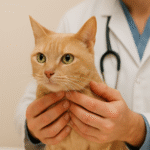Chlamydophila refers to a type of bacteria affecting cats that can cause infections like conjunctivitis, rhinitis, and respiratory disease. This obligate, intracellular pathogen spreads through feline ocular and nasal secretions. Chlamydophila felis strains commonly trigger infection while Chlamydophila psittaci strains less frequently cause illness in cats. If not treated promptly, chlamydophila can lead to lasting eye or lung damage. This article explores chlamydophila symptoms, transmission, diagnosis, treatment options, and prevention methods for optimal disease management in cats.
Signs Your Cat Has Chlamydophila
Infected cats often showcase these primary symptoms:
Conjunctivitis (Pink Eye)
– Red, swollen, runny eyes
– Eye inflammation
– Greenish or yellow eye discharge
– Squinting or sensitivity to light
Upper Respiratory Infection
– Sneezing
– Nasal discharge
– Loss of appetite
– Lethargy
– Breathing issues like rapid breathing or coughing
Without treatment, chlamydophila conjunctivitis can scar the eyes and cause vision problems. Similarly, upper respiratory infections may progress to pneumonia threatening lung tissue. Catching symptoms early and visiting the vet helps prevent long-term ocular or respiratory damage.
Transmission Between Cats
Chlamydophila spreads through direct contact with eye, nasal, or lung secretions of already infected cats. Nose-to-nose interaction easily passes the bacteria. Grooming between cats likewise leads to transmission. Infected mothers also frequently pass chlamydophila on to nursing newborn kittens.
Strains spread to cats from infected birds as well although cats pose minimal zoonotic risk for people. Still, proper handwashing after handling infected cats helps prevent bacterial spread. Following sound infection prevention principles allows households with infected cats to contain the outbreak.
Diagnosing Chlamydophila
Veterinarians use clinical history, observable symptoms, and diagnostic lab tests to pinpoint chlamydophila. Polymerase chain reaction (PCR) performed on conjunctival swabs or respiratory discharge can isolate the pathogen’s genetic material and confirm infection. Serology blood tests also detect antibodies specific to the chlamydophila bacterium.
Treatment Options for Cats
Since chlamydophila infection localizes inside cells, not all antibiotics effectively penetrate to clear it. Typical treatment includes:
– Doxycycline antibiotic for 3-4 weeks
– Topical ophthalmic tetracyclines or chloramphenicol
– Supportive eye lubricants and nasal decongestants
– Temporary corticosteroids to reduce swelling and irritation
Isolating infected cats during their lengthy treatment course prevents transmitting illness to other pets. Generally, cats show symptom resolution within 1-2 weeks but must finish the full antibiotic regimen. Follow up testing helps confirm complete elimination of the Chlamydophila organism.
Preventing Chlamydophila Transmission
No vaccine currently exists to prevent chlamydophila in cats. Still, responsible pet ownership limits outbreaks through:
– Isolating infected cats to prevent sharing eye/nasal secretions
– Thoroughly cleaning all bowls, bedding, litter boxes
– Disinfecting home surfaces with pet-safe antibacterials
– Washing hands before/after handling each cat
– Avoiding exposure to stray cats which may carry disease
– Spaying/neutering community cats through TNR programs
– Following vet recommendations for nursing kittens with suspected infections
Following proper treatment and disinfection protocols helps households containing Chlamydophila infections recover fully and avoid recurrence. Annual testing gives peace of mind cats remain clear. Protect all family cats through responsible ownership and supportive veterinary care.





